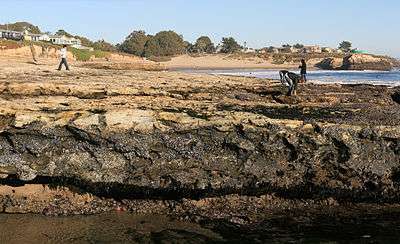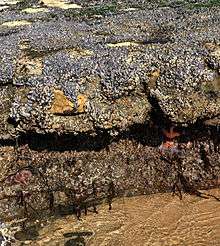Natural Bridges State Marine Reserve


Natural Bridges State Marine Reserve (SMR) is a marine protected area located at the northern edge of Santa Cruz, California, approximately 75 miles (121 km) south of San Francisco. The SMR covers 0.58 square miles (1.5 km2).[1] The SMR protects all marine life within its boundaries. Fishing or other removal of any living marine resource is prohibited. [2]
History
The California Department of Fish and Game established the Natural Bridges State Marine Reserve in September 2007. It was one of 29 marine protected areas adopted during the first phase of the Marine Life Protection Act Initiative (MLPAI), a collaborative public process to create a statewide network of marine protected areas along the California coastline.
Geography and natural features
Natural Bridges SMR is adjacent to Natural Bridges State Beach and Wilder Ranch State Park.
The marine protected area is bounded by the mean high tide line and a distance of 200 feet (61 m) seaward of mean lower low water between the following two points:[3]
- 36° 57.90’ N. lat. 122° 07.65’ W. long.; and
- 36° 57.00’ N. lat. 122° 03.50’ W. long.
Habitat and wildlife
Dramatic wave-cut platforms, exposed rocky cliffs, salt marsh, and sandy and rocky shores provide habitat for a wide range of species that inhabit Natural Bridges. These habitats include sandy beach, rocky intertidal, and surfgrass.[4]
Recreation and nearby attractions
Adjacent to the SMR is Natural Bridges State Beach which features tidepools and the Monarch Butterfly Natural Preserve. The Monarch Grove is home to migrating monarch butterflies from mid-October through the end of February. Docent–led butterfly, tidepool, and nature trail tours are available.
Also adjacent is Wilder Ranch State Park, which has 34 miles (55 km) of hiking, biking, and equestrian trails. Historic farm buildings have been restored and the park conducts tours and living history demonstrations.
The University of California at Santa Cruz's Long Marine Laboratory and its public aquarium, the Seymour Marine Discovery Center, are also adjacent. Long Marine Laboratory is an oceanside research and educational facility. Limited tours are available.
California's government encourages recreational and educational uses of the ocean and the marine protected areas.[5] Activities such as kayaking, diving, snorkeling, and swimming are allowed unless otherwise restricted.
For a virtual tour of the underwater park click here
Monitoring
As specified by the Marine Life Protection Act, researchers monitor selected marine protected areas along California’s central coast to track their effectiveness and learn more about ocean health. Similar studies in marine protected areas located by the Santa Barbara Channel Islands have detected gradual improvements in fish size and quantity.[6]
References
- ↑ California Department of Fish and Game. "California Marine Life Protection Act Initiative Summary of Central Coast MPAs as Adopted by the California Fish and Game Commission". Retrieved on December 22, 2008.
- ↑ California Department of Fish and Game. "Online Guide to California's Central Coast Marine Protected Areas". Retrieved on December 18, 2008.
- ↑ California Department of Fish and Game. "Central Coast Marine Protected Areas". Retrieved December 18, 2008.
- ↑ Department of Fish and Game. "Appendix O. Regional MPA Management Plans". Master Plan for Marine Protected Areas (approved February 2008). Retrieved December 18, 2008.
- ↑ Department of Fish and Game. "California Fish and Game Code section 2853 (b)(3)". Marine Life Protection Act. Retrieved December 18, 2008.
- ↑ Castell, Jenn, et al. "How do patterns of abundance and size structure differ between fished and unfished waters in the Channel Islands? Results from SCUBA surveys". Partnership for Interdisciplinary Studies of Coastal Oceans (PISCO) at University of California, Santa Barbara and University of California, Santa Cruz; Channel Islands National Park. Retrieved December 18, 2008.
External links
- California Marine Sanctuary Foundation
- Natural Bridges State Beach
- Wilder Ranch State Park
- Long Marine Laboratory
- Seymour Marine Discovery Center
- Marine Life Protection Act Initiative
- CalOceans